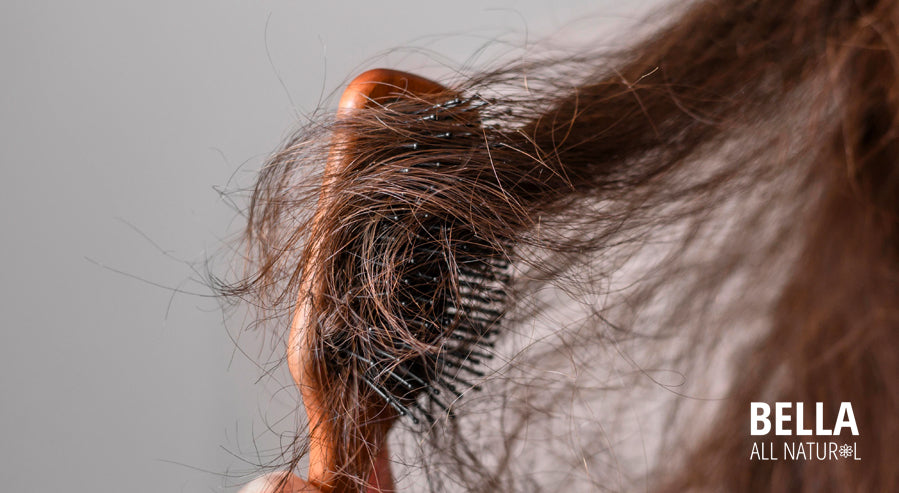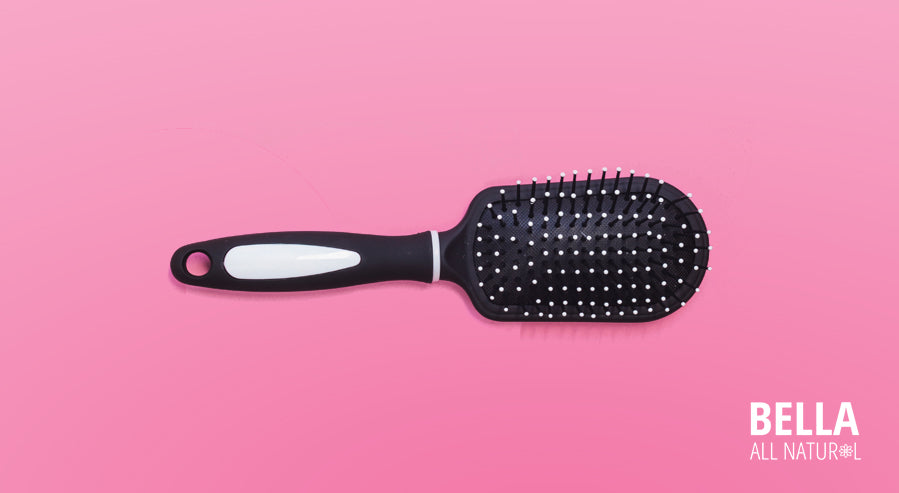

Anyone with even mildly thick, curly, or dense hair has to deal with tangles in the morning. Sleep tends to let the hair run wild, and that means it twists up, wraps around itself, ties itself in knots, and generally becomes a huge and painful hassle to deal with in the morning.
Is there any way you can manage your hair to help prevent those tangles? Here are some tips we've found in our experience over the years.
1. Always Use Conditioner
Conditioner is the number one trick to help with minimizing tangles in hair, both throughout your daily activities and through sleeping at night. Conditioner helps moisturize hair, but more importantly, it helps keep it slippery. That way it's less likely to tangle up and knot itself, and the tangles that do show up are a lot easier to brush out.
Properly using conditioner is a big factor in how successful it will be. A lot of people who use conditioners don't use it properly, and many who don't use conditioner decided not to because they didn't see results because of improper use.
So how do you use conditioner properly?
- Start by picking the right kind of conditioner. Different conditioners work best on different kinds of hair; curly hair, dense hair, thick hair, thin hair, dyed hair, heat-treated hair. They all have ideal conditioners, so browse the conditioner section or talk to your hairdresser about what will work best for you.
- Shampoo, rinse, and then wring out your hair before applying conditioner. The more water your hair has soaked up, the more the conditioner simply washes off and can't penetrate the hair itself.
- Only apply conditioner to the ends of your hair. Applying it to your scalp and the roots of your hair can cause over-conditioning, which makes your hair feel sticky.
- Give the conditioner enough time to set in. Some conditioners only need a couple of minutes, while others need most of the rest of your shower. Read the instructions on your conditioner to see how long it should be left in before rinsing.
You can also consider a daily leave-in conditioner throughout the day. You'll want to read and follow the instructions for that kind of conditioner as well, of course.
2. Use the Right Brush
Many of us just have a hairbrush we use, or maybe a brush and a comb, but how many of us have a full suite of different brushes available? Not as many of us as there should be, that's for sure.
Using the wrong kind of brush to remove tangles can damage your hair and your hair follicles. Not only does it break hair and cause small knots in individual strands that lead to future tangles, but it can also hurt the scalp and lead to future hair loss. 
So, what kind of brush should you be using? There are different brushes for different hairstyles and textures. Use a flat paddle brush for daily brushing and detangling, and a wide-toothed comb for post-shower and evening combing to set things in order without risking more tangles down the line.
Be gentle and take your time when brushing your hair. Start from the bottom up and work at tangles gentle to release them, so you don't tie them into knots, break the hair, or rip it right out of your scalp. Yes, it takes a while, and it can be frustrating to work with stubborn knots, but it's well worth the effort to prevent future tangles.
3. Braid Before Sleep
Tangles that occur when you're sleeping happen because of the hair rubbing against itself while you toss and turn in your sleep. Hair rubs against hair, it wraps around and threads through, and when you wake up, you have mats, knots, and tangles everywhere.
This is, of course, worse if you're a restless sleeper and you shift and roll around a lot. While this post is primarily about hair care, you can look elsewhere for tips on how to sleep better. Proper sleep hygiene can help reduce how much you're moving around, and thus how much you're tangling your hair. Plus, you'll feel a lot better when you get a full night's sleep without minor interruptions.
Among the best solutions to this issue is to tie your hair back properly before you go to sleep. If you have thicker hair or very long hair, a loose braid is generally the way to go. You don't want it too tight, or else the stress and pulling on the hair can pull it loose from your scalp. You don't want it too loose, or else it can still rub together and get knotted up while you sleep. A moderately tight but still loose braid is best.
If you have thinner or shorter hair, you can do a bun instead. You don't have to go all-in with a beauty bun or a messy bun, though they can work just fine. A simple bun is all you need to keep your hair up, out of the way, and relatively isolated from tossing and turning.
4. Brush More Often
Brushing your hair more often helps prevent the build-up of minor tangles and damage, and keeps your hair gently separated without yanking on it too much. Brush your hair several times throughout the day, especially if you're just coming in from spending time outside, if you were out in the wind, or if you've kept it down for a while. In general, when you're out and about, keeping your hair back and tied up can help prevent those tangles from forming in the first place as well.
Pay special attention to brushing your hair in the morning, before a shower, and before bed. You, again, want to be as gentle as possible while brushing your hair, to prevent damage. Make sure to use the right kind of brush as well, so you don't run into problems with too-fine or too-coarse bristles pulling on tangles.
5. Change Styles Regularly
Keeping up the same hairstyle for days on end can put semi-permanent waves, crimps, twists, or curls in your hair. Even a simple hair tie can do a lot of damage if you keep your hair tied in the same position all the time. Keeping your hair tightly braided or tied back in a ponytail all day, every day, is a great way to damage some portions of your hair.
If you're used to a ponytail and want to keep your hair back out of your face, try some variations on it. Tie the ponytail lower or higher on your head, or split into two and go for something closer to pigtails. Scrunchies also work better and are gentler on your hair than tighter hair elastics and hair ties.
Braids are simple, versatile, and look good on most people. If you have very long hair and don't want to spend the time braiding it, go with a simple braid. If you have more time (or help), go with a French braid or a fishtail braid for a more complex and interesting look that holds your hair more evenly.
6. Avoid Heat
Heat damages hair. There's not a whole lot of things to get around that point - any sort of heat will start to break down your hair. Why does this happen?
Heat dries out hair and removes natural moisture. It makes hair more pliable and able to hold shape better, but it does that by essentially breaking it down and re-forming it in the position you want it. That's why heat treatments and heat-based hairstyles leave hair so fragile and thin so often, and why there's a whole regimen of shampoos, conditioners, and other products prescribed to go along with any standard heat treatment, straightening, or curling process.
Many of you already know not to apply too much heat to your hair, so you avoid things like heat-based salon treatments. How many of you, though, choose to use a blow dryer to speed up drying hair after a shower? If so, we recommend minimizing this as much as possible. Remember, heat will damage your hair.
Some people even recommend rinsing your hair after a shower with cold water rather than hot water. This is a tall order, especially when it's cold out, but they swear that it closes the follicles and makes you less prone to tangles, damage, and scalp irritation. We're not sure we believe them, but hey, if you can stand the habit, it might be worth trying.
7. Wrap in Silk
Another aspect of tangled hair when you sleep is your pillow. The texture of your pillowcase can cause friction when you move as you sleep, and as mentioned above, that can lead to a lot of minor tangles and knots, which turns into major tangles and knots down the road. Cotton is the biggest offender here.
To help alleviate this issue, consider buying a silk pillowcase with a high thread count. You don't need to go all-out and buy a full set of silk sheets, but a pillowcase will do wonders for your hair in the mornings. You might not even believe us how big of a difference it can make.
If you don't want to go with a silk pillowcase – for example, if you don't like the texture, and it makes you toss and turn more or sleep worse – you can also try something like a silk bonnet. Tie up or braid your hair loosely before bed, and then cap it off with a silk bonnet. It takes some getting used to, but it's a great option.
8. Eat a Hair-Healthy Diet
A lot of the damage that your hair takes over time can be attributed to poor hair health. Healthy hair is more resistant to moisture loss, sun damage, and other forms of damage, and thus won't knot or tangle up nearly as often.
The first step to solving this issue is repairing the damage that has been done to your existing hair. The worst bits of hair (the split ends and the brittle bits of hair) might need to be cut off. A shorter hairstyle won't tangle as often, you know, though it can still happen.
We have a whole post here about natural home remedies you can use to help repair and restore damaged hair. It's mostly hair masks, moisturizing and reinvigorating your hair with natural oils, and adding some things like eggs to your diet to improve the overall quality of your hair.
Unfortunately, hair isn't exactly a living thing. Unlike your skin, it can't heal from damage; you can only smooth over cracks. Once natural oils are stripped, you have to replace them.
You can also expand or tweak your diet to include some more hair-healthy nutrients. Your hair needs certain vitamins, minerals, and nutrients to grow strong, thick, and healthy. You need protein, biotin, zinc, vitamins A, B3, B6, C, and E, iron, and collagen.
For a list of possible food that you can eat to give you more of these valuable nutrients, check out this post here. If you've been eating a relatively healthy diet as part of your daily life, you shouldn't need to change much. If you haven't, adjusting your diet can bring you a lot of potential health benefits, including more lustrous and resilient hair.
Wrapping Up
Hair isn't as much of a mystery as some people would like to believe it is. Your hairdresser isn't a wizard, they just know how hair works. You can learn, all you need to do is identify your hair type, pick products that work best for it, and treat it well in between salon visits.
Do you have a go-to hair tip to help minimize tangles throughout daily life or when sleeping? If so, let us know in the comments section!



